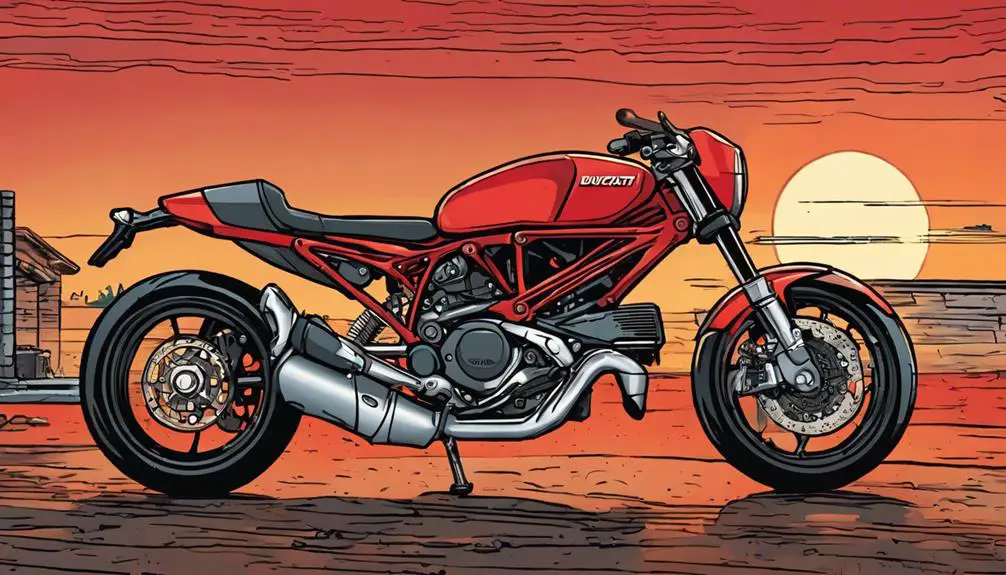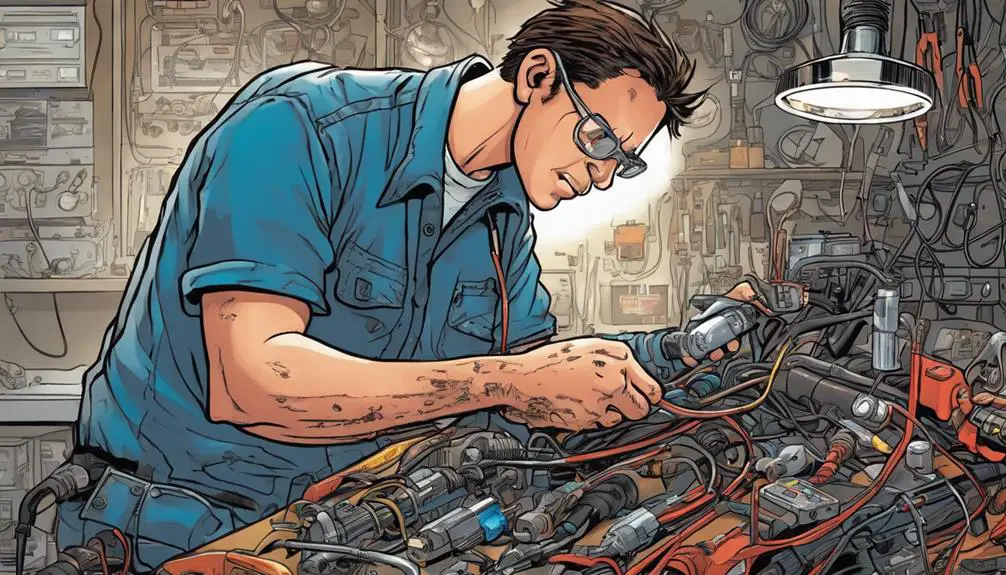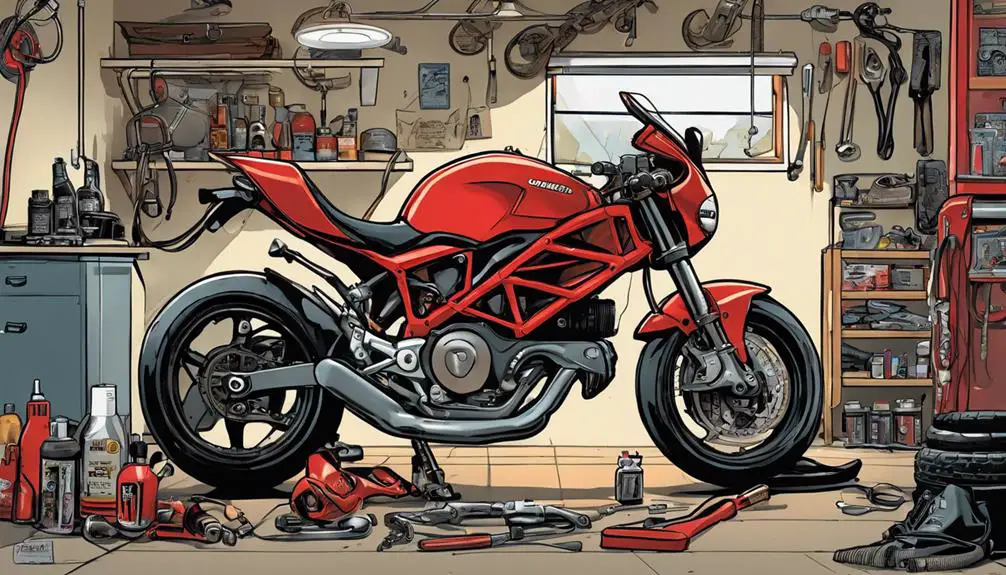Your motorcycle is like a finely tuned machine, and when it stutters or hesitates, it signals the need for attention. You might not realize it, but understanding the basics of motorcycle troubleshooting can save you time and money. From deciphering electrical issues to diagnosing engine performance, knowing what to look for is essential. As you begin to uncover these common problems, you'll find that the journey of maintenance can be just as rewarding as the ride itself. What steps can you take to guarantee your bike remains in peak condition?
Key Takeaways
- Start with basic checks: ensure the battery is charged and connections are secure before troubleshooting further issues.
- Inspect fuses for any blown units that could disrupt electrical components and cause starting problems.
- Check for fuel system issues, including clean fuel and unclogged lines, to ensure proper engine performance.
- Regularly maintain your motorcycle by adhering to oil change intervals and inspecting tires, brakes, and air filters.
Overview of Ducati Motorcycles

Ducati motorcycles are known for their stunning design, advanced technology, and high-performance capabilities, making them a favorite among riders. When you climb onto a Ducati, you're not just riding; you're embracing a lifestyle that celebrates freedom, speed, and precision handling. The brand combines Italian craftsmanship with cutting-edge engineering, resulting in machines that are as beautiful as they're powerful.
Each model in the Ducati lineup offers something unique, whether it's the aggressive stance of a Panigale or the rugged versatility of a Multistrada. You'll appreciate the attention to detail, from the sleek lines to the throaty roar of the engine. Ducati's commitment to innovation means you benefit from advanced features like traction control, cornering ABS, and ride modes that adapt to your style.
With a Ducati, you're part of a passionate community that values the thrill of the ride. The bike becomes an extension of your spirit, allowing you to explore the open road and express your individuality.
Common Ducati Issues
When owning a Ducati, you'll want to be aware of some common issues that can arise with these high-performance machines.
First, keep an eye on the desmodromic valve system. While it's a brilliant engineering feat, it requires regular maintenance to prevent performance dips. If you hear unusual noises from the engine, it might be time for a valve adjustment.
Next, watch out for oil leaks, particularly around the oil cooler and gaskets. These leaks can lead to bigger engine problems if not addressed promptly.
Additionally, the fuel pump can be finicky, especially on older models. If you notice starting issues, it could be a sign that your pump needs attention.
Another common issue is the belt replacement interval, which should be adhered to strictly to avoid catastrophic engine failure.
Troubleshooting Electrical Problems

Electrical problems can frequently be the source of frustration for motorcycle owners, but with a systematic approach, you can diagnose and resolve these issues effectively. Start by focusing on the basics; a few common culprits can often lead to bigger problems if left unchecked.
Battery Issues:
Check the battery's charge and connections. A weak or dead battery can prevent your bike from starting. Clean any corrosion from the terminals and guarantee tight connections.
Fuses and Wiring:
Inspect the fuses in your fuse box. A blown fuse may cause certain electrical components to fail. Additionally, look for damaged or exposed wiring that could cause shorts, which often lead to erratic behavior.
Switches and Relays:
Test your switches and relays for functionality. Faulty switches can prevent signals from reaching their destination, causing lights or signals to fail.
Engine Performance Diagnosis
Diagnosing engine performance issues requires a clear understanding of the signs your motorcycle gives you, such as poor acceleration, rough idling, or unusual noises. When you notice these symptoms, it's essential to take action.
Start by checking the fuel system. Make sure you have clean fuel and that the fuel lines are free from clogs. A dirty air filter can also restrict airflow, so inspect and clean or replace it if necessary.
Next, listen for any abnormal sounds. Knocking or tapping can indicate internal issues, while a backfire could suggest a problem with the ignition system. If you're experiencing rough idling, it may point to an issue with the carburetor or fuel injection system.
Don't forget to examine your spark plugs; worn or fouled plugs can lead to poor performance.
If you're still having trouble, consider checking the exhaust for blockages or leaks, as these can greatly impact engine efficiency.
Maintenance Tips for Ducati Owners

Proper maintenance is essential for keeping your Ducati performing at its best and guaranteeing a thrilling ride every time. By following these simple tips, you can embrace the freedom of the open road without worry.
- Regular Oil Changes: Change your oil every 5,000 miles or annually, whichever comes first. Fresh oil keeps your engine running smoothly, allowing you to release the power of your Ducati.
- Check Tire Pressure: Maintain the right tire pressure for ideal grip and stability. Inspect your tires regularly to avoid unnecessary wear and guarantee a responsive ride.
- Inspect Brake Pads: Your safety depends on effective braking. Check your brake pads and fluid levels frequently. Replace worn pads immediately to maintain that exhilarating control you crave.
Frequently Asked Questions
What Tools Are Essential for Basic Motorcycle Troubleshooting?
When you're diving into basic motorcycle troubleshooting, having the right tools makes all the difference.
You'll want a set of wrenches, screwdrivers, and pliers for quick fixes. A torque wrench guarantees you don't over-tighten bolts, while a multimeter helps with electrical issues.
Don't forget a tire pressure gauge and a basic toolkit for general maintenance. With these essentials, you'll feel empowered to tackle any challenge that comes your way on the road.
How Do I Identify My Ducati Model for Accurate Repairs?
To uncover your Ducati's identity, think of it as a puzzle waiting to be solved.
Start by checking the frame and engine numbers, usually stamped on the bike. Compare these with online resources or Ducati's official site for precise identification.
Don't forget to look at the owner's manual or any registration documents you have.
Once you know your model, you'll feel empowered to tackle repairs and release the full potential of your ride.
What Safety Gear Should I Wear While Troubleshooting?
When you're troubleshooting, safety gear is essential. You should wear a good-quality helmet, gloves, and durable clothing to protect against any hazards.
Sturdy boots are critical too, providing ankle support and grip. Consider eye protection, especially if you're working with tools or near fluids.
Your skin deserves protection from sharp edges and hot surfaces, so cover up.
Where Can I Find Ducati Repair Manuals or Guides?
Did you know that over 50% of motorcycle enthusiasts prefer DIY repairs?
If you're looking for Ducati repair manuals or guides, check out online forums, Ducati's official website, or motorcycle-specific sites like Haynes or Clymer.
You can also find valuable resources on eBay or Amazon.
Don't forget to check out local libraries or community colleges; they often have manuals available.
Get ready to release your inner mechanic and take control of your ride!
How Do I Properly Store My Ducati During Winter Months?
To properly store your Ducati during winter months, start by cleaning it thoroughly to remove dirt and grime.
Then, add fuel stabilizer to the tank and run the engine for a few minutes.
Next, change the oil and filter to protect the engine.
Inflate the tires, and ideally, keep the bike on a stand to prevent flat spots.
Conclusion
By staying proactive with your Ducati's maintenance and knowing how to troubleshoot common issues, you can enhance your riding experience.
Did you know that around 70% of motorcycle breakdowns are linked to electrical problems? Keeping an eye on your battery, fuses, and wiring can save you from unexpected roadside troubles.
Embrace the joy of riding confidently, knowing you're equipped with the skills to tackle any challenge that comes your way.
Enjoy every ride!